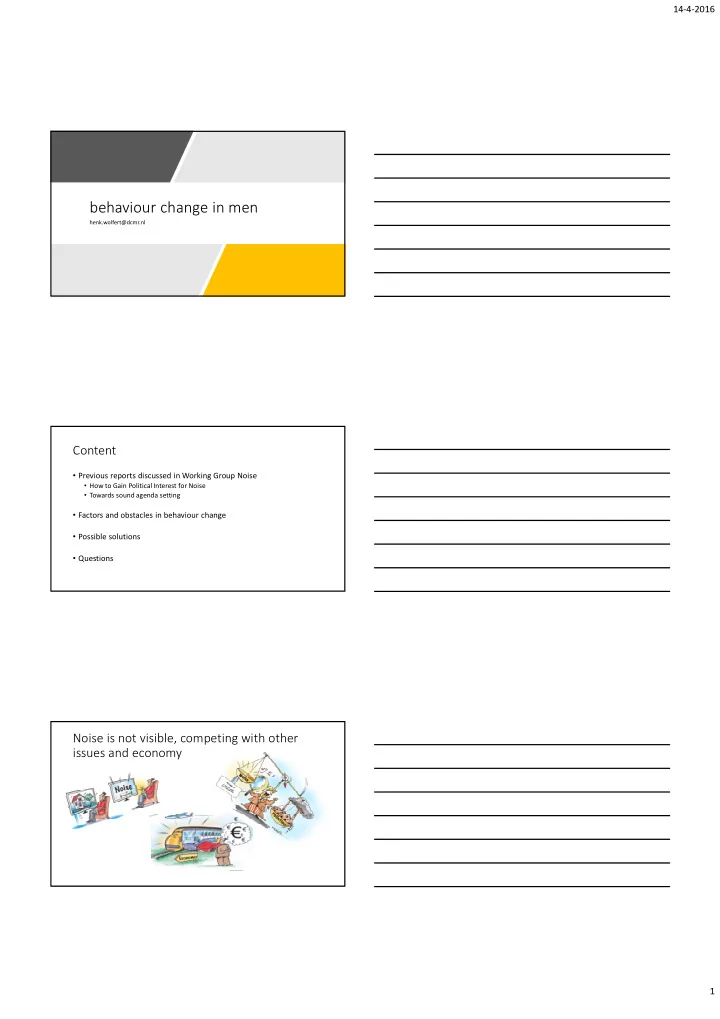

14-4-2016 behaviour change in men henk.wolfert@dcmr.nl Content • Previous reports discussed in Working Group Noise • How to Gain Political Interest for Noise • Towards sound agenda setting • Factors and obstacles in behaviour change • Possible solutions • Questions Noise is not visible, competing with other issues and economy 1
14-4-2016 Other constraints • Lack of willingness to tackle noise • Measures and counter productive developments • Metrics (decibel) hard to understand • Lack of trust in evidence on noise and health • Noise is often labelled as subjective • Effectiveness of measures against noise • Lack of a suitable unit • Lack of clear limit value in END • Technical measures not aiming at the source • Technical measures have been countered OBSTACLES [internal factors] emotion internal locus of control responsibilities priorities external awareness •values •ethics motivation •hedonistic •egoistic •norms interest intention •beliefs education/ attitude behaviour knowledge •positive (+) or •autonomous negative (-) •planned •cognitive •Intuitive • demographics •FORMAL gender •INFORMAL yrs.education •yrs. of education Institutional Economic Social/cultural External factors factors factors factors Institutional factors • Infrastructure such as: • Public transport • Information panels • Comfortable, safe, secure bus stops • Sufficiënt bus stops • Bike lanes • Last mile solutions( bikes, e-scooters, etc) • Intermodal options 2
14-4-2016 Economic factors • Cheaper (treshold 25%) • Faster • Healthier • Affordable (low incomes) • Incentives • Return on investment • Negative feedback social environment • Etnic background • Social Economic Status (SES) • Education • Income • Neigbourhoud (broken windows theory) Connections between noise annoyance and Complex health Education (parents, social networks, emerging Connections between noise and other media, et cetera) environmental issues Carrot and stick Connections with the media Incentives/rewards Attractiveness Connections between the public and policy Legislation Connections between the different levels of Taxation policy Financial Make use of policy windows (incidents, Role models political earthquakes, ,……… Removing obstacles as much as possible et cetera Persuasion Report Souren et all. 2009 3
14-4-2016 OBSTACLES [internal factors] emotion internal locus of control responsibilities priorities external awareness •values •ethics motivation •hedonistic •egoistic •norms interest intention •beliefs education/ attitude behaviour knowledge •positive (+) or •autonomous negative (-) •planned •cognitive •Intuitive • demographics •FORMAL gender •INFORMAL yrs.education •yrs. of education Institutional Economic Social/cultural External factors factors factors factors Persuasion Malcolm Gladwell (tipping point) Robert Cialdini (principles) reciprocity law of commitment social proof & consistency few scarcity liking stickiness power of factor context authority 4
14-4-2016 Stickiness factor The specific content of a message that renders its impact memorable. Popular children's television programs such as pioneered the properties of the stickiness factor, thus enhancing effective retention of educational content as well as entertainment value. Power of context 5
14-4-2016 More vigorous interventions & coordination -legislation & policies -technical & logistical -physical environment -leading by example AND…………. communication Informing the public campaigning government needs & obstacles in target groups motivation instruments/approaches stragglers (stay behind) behaviour change frontrunners social NGO's scientists Questions 1: • Who are the connectors in our network? • Who are the mavens in network? • Who are the salesman in our network? How to strenghten influence with “tools” provided by Cialdini see next sheet. 6
14-4-2016 Questions 2: What’s in it for policymakers/politicians when it comes to noise? Do we have numbers of cities/politicians that show desired behaviour? Do we know people that are likable for politicians/policymakers (social network,..) Do we know people that are seen as authorities (experts, position, title)? Are there noise issues that are scarce and unique and/or attractive? Can you appeal on previous behaviour/policies? 7
Recommend
More recommend